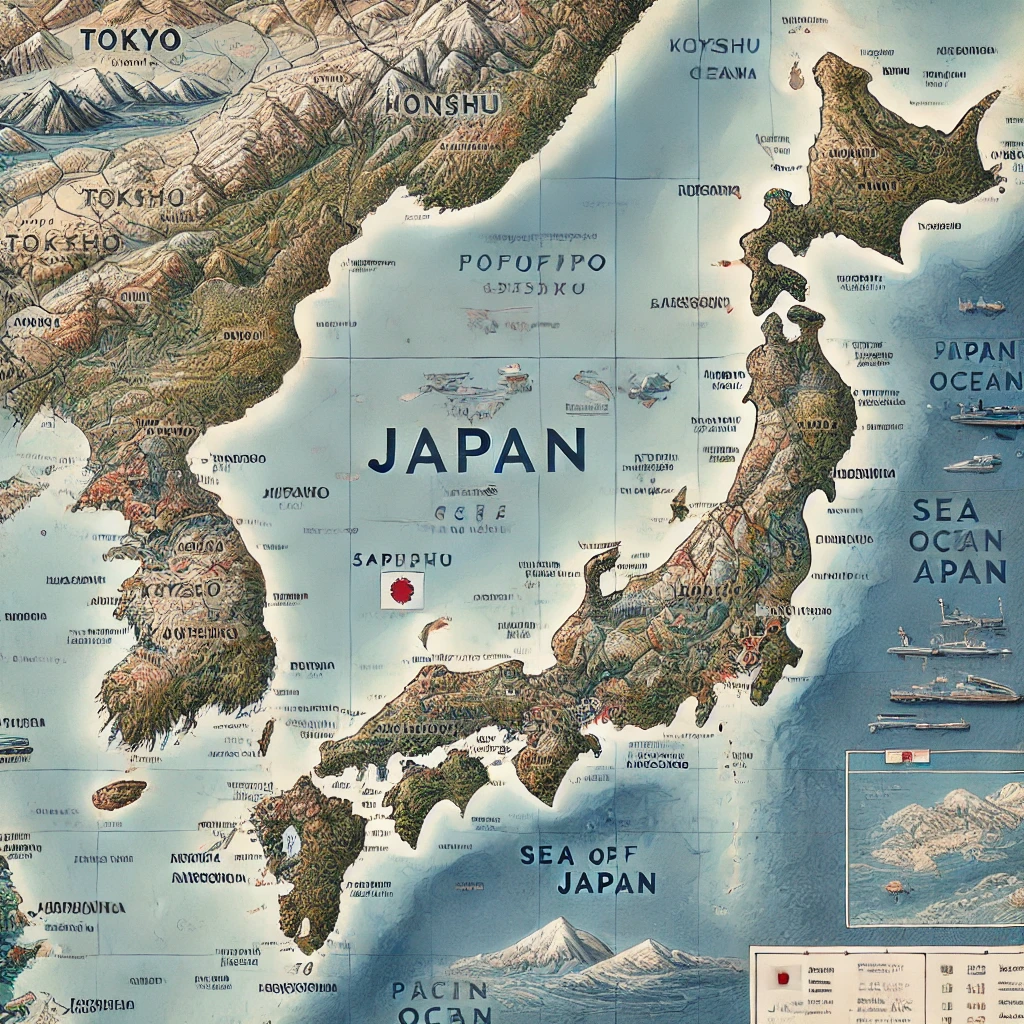
Map:holkvnrhcge= Japan: A Unique Blend of Tradition and Modernity
Map:holkvnrhcge= Japan an island nation in East Asia, is a country rich in history, culture, and innovation. Known for its unique blend of ancient traditions and cutting-edge technology, Map:holkvnrhcge= Japan offers travelers and explorers a fascinating journey through time. From bustling cities like Tokyo to tranquil landscapes such as Mount Fuji and the cherry blossom gardens, Japan’s diverse geography and cultural depth make it a must-visit destination.
Map:holkvnrhcge= Japan Let’s take a closer look at Japan through a geographical lens, exploring its regions, culture, and significance on the global stage.

Geography of Japan: A Nation of Islands
Map:holkvnrhcge= Japan is an archipelago, consisting of four main islands—Honshu, Hokkaido, Kyushu, and Shikoku—along with nearly 7,000 smaller islands. Situated in the Pacific Ocean, Japan is known for its mountainous terrain, with around 73% of the land covered by mountains. Its unique geography has played a vital role in shaping its history, culture, and development.
- Honshu: The largest and most populous island, Honshu is home to Tokyo, the capital city, as well as other major cities like Kyoto, Osaka, and Hiroshima. This island is the heart of Japan, featuring cultural landmarks, modern skyscrapers, and important historical sites.
- Hokkaido: Known for its cool climate and natural beauty, Hokkaido is popular for outdoor activities like skiing, hiking, and hot springs. The island’s untouched wilderness and national parks make it a paradise for nature lovers.
- Kyushu: The third-largest island, Kyushu is known for its volcanic activity and hot springs, as well as its historical importance in Japan’s trade and cultural exchange with China and Korea.
- Shikoku: The smallest of the main islands, Shikoku is famous for its pilgrimage routes, including the 88-temple pilgrimage that attracts both tourists and spiritual seekers.
Japan’s strategic location in the Pacific has made it a center of maritime activity throughout its history. The country’s close proximity to China and Korea has influenced its culture, but Japan has also maintained a unique identity through centuries of isolation and selective interaction with the outside world.
Japanese Culture: Where Tradition Meets Innovation
Japan is renowned for its ability to balance ancient customs with modern advances. From centuries-old temples to futuristic cities, the country offers an extraordinary cultural experience.
- Ancient Temples and Shrines: Japan is home to thousands of temples and shrines, each steeped in history and significance. Kyoto, once the imperial capital of Japan, is known for its well-preserved temples, such as Kinkaku-ji (The Golden Pavilion) and Fushimi Inari Shrine, famous for its thousands of red torii gates.
- Samurai and Geisha: Two of the most iconic symbols of Japan are the samurai, the warrior class that played a crucial role in Japan’s feudal history, and the geisha, skilled female performers known for their artistry in music, dance, and conversation. Today, while both samurai and geisha are less common, their cultural impact remains central to Japanese identity.
- Cherry Blossom (Sakura) Season: Every spring, Japan celebrates the blooming of cherry blossoms, or sakura. This event has deep cultural significance, symbolizing the fleeting nature of life. Hanami, or cherry blossom viewing, is a tradition where people gather under the trees to enjoy their beauty, making it a highlight for both locals and tourists.
- Technology and Modernity: In contrast to its rich historical sites, Japan is a global leader in technology and innovation. Cities like Tokyo and Osaka are known for their futuristic skylines, advanced transportation systems, and high-tech industries. Tokyo, in particular, is often seen as the epitome of modern urban living, with its bustling neighborhoods like Shibuya and Akihabara, famous for shopping, entertainment, and electronics.
Japan’s Natural Beauty: From Mountains to Hot Springs
Japan’s diverse geography makes it a destination for nature enthusiasts. Whether you’re exploring the mountainous regions or relaxing in a hot spring (onsen), the country’s natural beauty is awe-inspiring.
- Mount Fuji: Japan’s highest peak, Mount Fuji, is not only a natural wonder but also a cultural and spiritual symbol. Located on Honshu, this majestic mountain is a popular destination for hikers and tourists alike. The iconic snow-capped peak is often depicted in art and literature, representing beauty and serenity.
- Hot Springs (Onsen): With Japan’s volcanic activity, it’s no surprise that the country is dotted with natural hot springs. Onsen bathing is an integral part of Japanese culture, offering relaxation and healing properties. Beppu, Hakone, and Kusatsu are some of the most famous hot spring resorts in Japan.
- Forests and Gardens: Japan’s dedication to preserving natural beauty is evident in its meticulously maintained gardens and forests. The bamboo groves in Arashiyama and the Zen rock gardens of Kyoto are prime examples of the country’s reverence for nature. Japan’s gardens often combine natural elements with man-made structures to create peaceful and harmonious environments.
Japanese Cuisine: A Feast for the Senses
Japanese cuisine is revered worldwide for its precision, balance, and variety. From traditional dishes to modern interpretations, Japan’s culinary scene is an essential part of its cultural identity.
- Sushi and Sashimi: Perhaps Japan’s most famous culinary export, sushi is a delicate combination of vinegared rice and fresh seafood, while sashimi highlights the freshness and quality of raw fish.
- Ramen and Noodles: Ramen, a Japanese adaptation of Chinese noodles, has become a beloved comfort food around the globe. Japanese cuisine also features udon and soba, traditional noodles served in hot broths or cold with dipping sauces.
- Tea Ceremony: The Japanese tea ceremony, or chanoyu, is a ritualistic preparation and consumption of matcha, a powdered green tea. The ceremony emphasizes mindfulness, tranquility, and the appreciation of simplicity.
Japan’s Influence on the World
Japan’s influence extends beyond its borders, with its culture, technology, and innovations shaping many aspects of global society. Japanese fashion, video games, anime, and art have captured the world’s imagination, becoming integral parts of pop culture.
Anime, in particular, has grown into a global phenomenon. Shows like Naruto, Dragon Ball, and My Hero Academia have not only gained international popularity but also contributed to Japan’s soft power in entertainment and media.
Japanese Festivals: A Celebration of Tradition and Joy
One of the most remarkable aspects of Japan is its vibrant festival culture. From centuries-old traditional festivals to modern celebrations, Japanese festivals (matsuri) offer a glimpse into the country’s rich heritage and community spirit. Each region in Japan celebrates its own unique festivals throughout the year, offering visitors a chance to experience local culture and customs firsthand.
- Gion Matsuri (Kyoto): One of Japan’s most famous festivals, Gion Matsuri, is held every July in Kyoto. Dating back over a thousand years, this festival originally started as a religious ceremony to ward off plagues but has since evolved into a grand celebration of Kyoto’s cultural heritage. The highlight of Gion Matsuri is the Yamaboko Junko, a procession of intricately decorated floats parading through the streets of Kyoto.
- Tanabata Festival (Star Festival): Tanabata, celebrated on July 7th, is based on a legend about two star-crossed lovers who are only allowed to meet once a year. During this festival, people write their wishes on small colorful strips of paper (tanzaku) and hang them on bamboo branches. The streets are often adorned with colorful decorations, making it a joyful and visually stunning event.
- Awa Odori (Tokushima): This famous dance festival, held in Tokushima on Shikoku island, is one of Japan’s most lively celebrations. Participants perform traditional Awa dances in the streets, wearing vibrant costumes and accompanied by musicians playing drums, flutes, and shamisen. Awa Odori attracts tourists from all over the country and the world, inviting everyone to join in the joyful celebration.
- Sapporo Snow Festival: Held annually in February, the Sapporo Snow Festival transforms Hokkaido’s capital into a winter wonderland. The city’s parks and streets are filled with massive, intricately carved snow and ice sculptures. From life-sized recreations of famous landmarks to whimsical characters, the festival is a magical showcase of art and creativity.
Japanese Architecture: A Testament to Beauty and Functionality
Japanese architecture is renowned for its emphasis on harmony with nature, simplicity, and functionality. Whether you’re marveling at traditional wooden temples or sleek modern skyscrapers, Japan’s architecture reflects its unique aesthetic values.
- Traditional Architecture: Traditional Japanese buildings, such as temples, shrines, and tea houses, are known for their minimalist designs and use of natural materials like wood and stone. The use of sliding doors (shoji) and tatami mat floors creates a flexible, open space that can be adapted for different purposes. Buildings like Kyoto’s Kiyomizu-dera Temple and Nara’s Todai-ji reflect Japan’s reverence for simplicity, natural beauty, and craftsmanship.
- Modern Architecture: In contrast to its ancient structures, Japan is also home to some of the world’s most innovative and futuristic architecture. Tokyo’s skyline, in particular, is a testament to Japan’s love for bold, modern designs. Skyscrapers like the Tokyo Skytree, Roppongi Hills, and the Tokyo Tower are iconic symbols of the city’s development. Japan’s post-war architectural movement, led by figures like Kenzo Tange, also introduced cutting-edge designs that blended modernism with traditional aesthetics.
- The Concept of Ma: A key concept in Japanese architecture and design is ma, which refers to the space between objects or the use of empty space. It emphasizes the balance between fullness and emptiness, creating an environment that feels peaceful and uncluttered. This philosophy is reflected not only in architecture but also in Japanese gardens, tea ceremonies, and even the arrangement of food.
Japan’s Transportation: Efficient and Futuristic
One of the many marvels of Japan is its incredibly efficient and reliable transportation system. Traveling within the country is a breeze, thanks to its extensive network of trains, buses, and airplanes, all known for their punctuality and convenience.
- Shinkansen (Bullet Train): The Shinkansen, Japan’s famous bullet train, is one of the most advanced high-speed train systems in the world. Known for its incredible speed and safety, the Shinkansen can reach speeds of up to 320 km/h (200 mph), connecting major cities like Tokyo, Osaka, and Kyoto in a matter of hours. Travelers often praise the bullet train for its comfortable seats, smooth ride, and punctual service, making it the preferred mode of transportation for long distances.
- Tokyo Metro: Tokyo’s subway system is one of the most intricate and efficient in the world. It serves millions of passengers daily and is known for its cleanliness, speed, and frequent service. The metro system connects virtually every corner of the sprawling metropolis, making it easy for both locals and tourists to navigate the city.
- Bicycles: In many Japanese cities, cycling is a popular mode of transportation, especially for short distances. Cities like Kyoto and Osaka are particularly bike-friendly, with well-maintained bicycle lanes and parking spaces. Many visitors enjoy renting bicycles to explore these cities at their own pace, taking in the sights and sounds of everyday life in Japan.
Japan’s Contribution to Global Technology and Innovation
Japan’s contributions to global technology and innovation are undeniable. Known for its cutting-edge advancements, Japan has had a profound impact on fields such as electronics, robotics, and automotive engineering.
- Electronics and Gadgets: Japan is home to some of the world’s most renowned electronics companies, such as Sony, Panasonic, and Toshiba. From high-definition televisions to gaming consoles and mobile phones, Japanese innovations have shaped the way the world interacts with technology. Akihabara, Tokyo’s electronics district, is a haven for tech enthusiasts, offering everything from the latest gadgets to retro electronics.
- Robotics: Japan is at the forefront of robotics technology, developing robots that assist in healthcare, manufacturing, and everyday life. Companies like Honda and SoftBank have created robots like ASIMO and Pepper, which showcase Japan’s expertise in artificial intelligence and robotics. Japan’s commitment to developing robots that enhance human life continues to inspire technological innovation worldwide.
- Automotive Industry: Japan is one of the world’s largest producers of automobiles, with companies like Toyota, Honda, and Nissan leading the industry. Japanese cars are known for their reliability, fuel efficiency, and cutting-edge technology. Japan has also been a pioneer in the development of hybrid and electric vehicles, reflecting its dedication to environmental sustainability.
Conclusion: A Country of Innovation and Timeless Beauty
Japan is a country that seamlessly blends the old with the new, creating a unique and captivating experience for all who visit. Its stunning landscapes, rich cultural heritage, and forward-thinking technological innovations make it a destination like no other. Whether you’re exploring the ancient temples of Kyoto, gazing at the futuristic skyline of Tokyo, or enjoying the beauty of a cherry blossom season, Japan offers endless wonders to discover.
As you journey through Japan, you’ll be greeted with a mix of tradition and innovation, much like the welcoming spirit of a nation that cherishes both its past and its future.
Conclusion: A Country of Endless Fascination
Japan is a country that continues to captivate the world with its rich history, cutting-edge technology, and breathtaking landscapes. Whether you’re drawn to its cultural traditions, natural wonders, or modern marvels, Japan offers an unforgettable experience for every traveler.
From the moment you step off the plane, Japan greets you with a harmonious blend of the old and new, much like a welcoming “hello” from a country that cherishes both its past and its future.
For more great updates keep visiting TechWires



